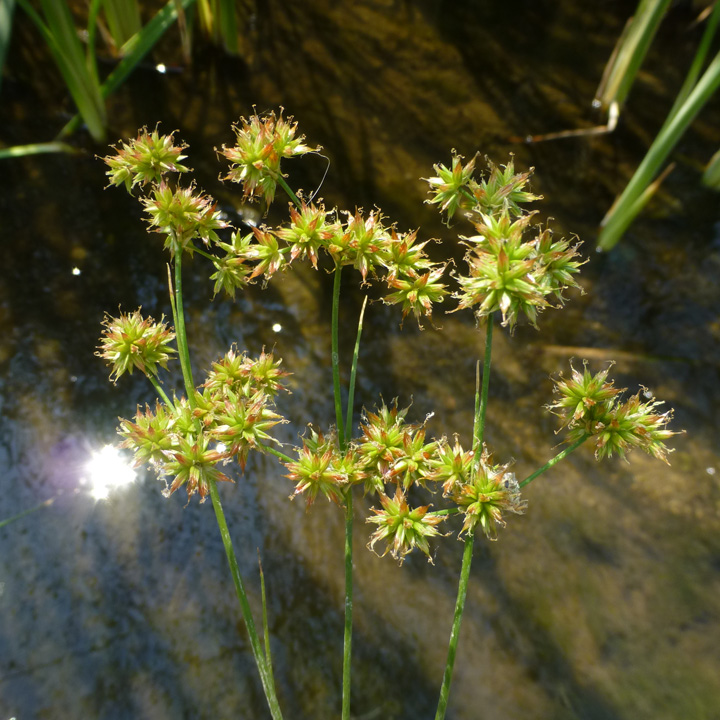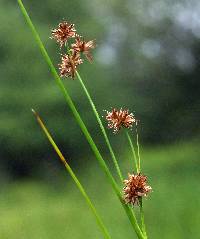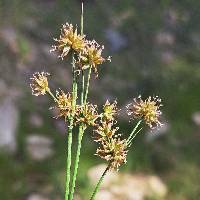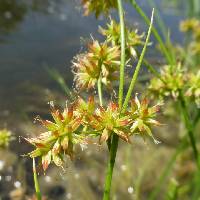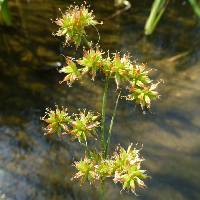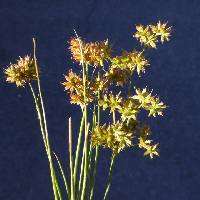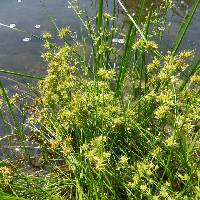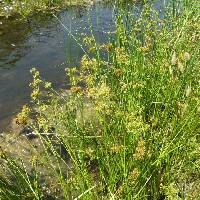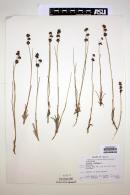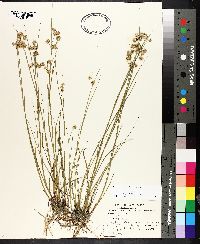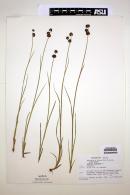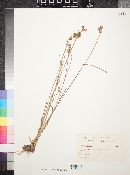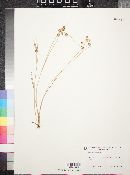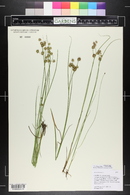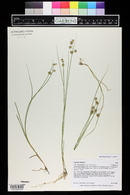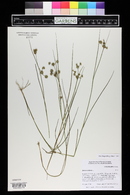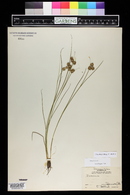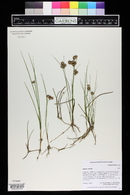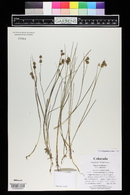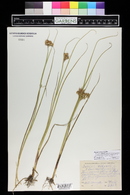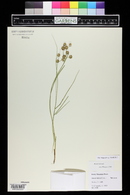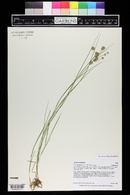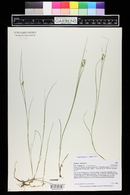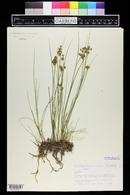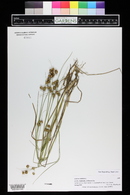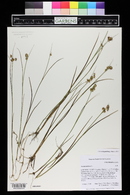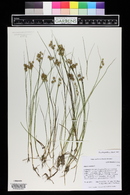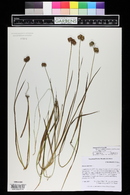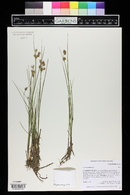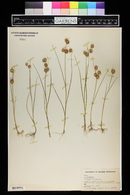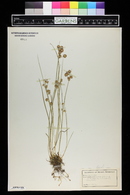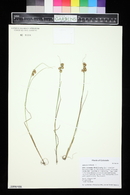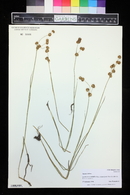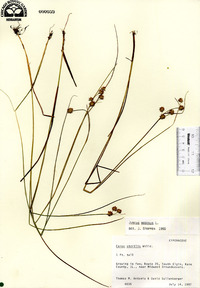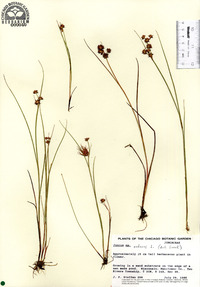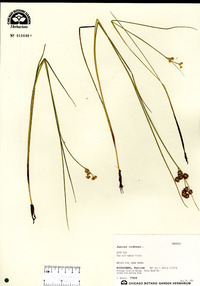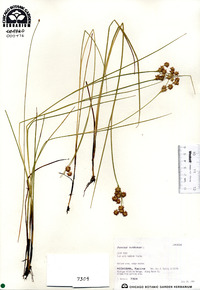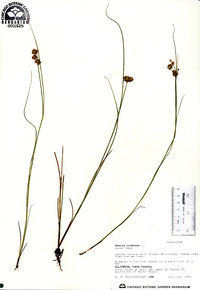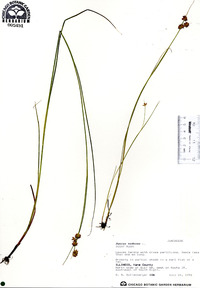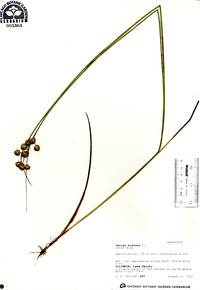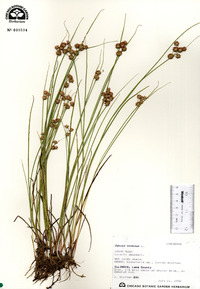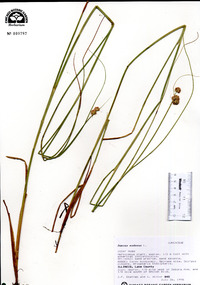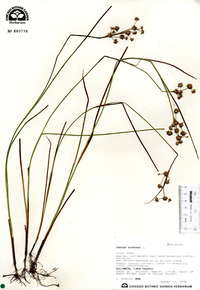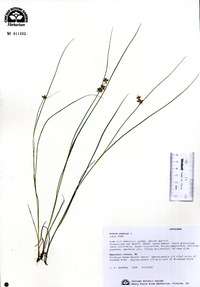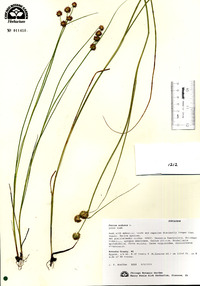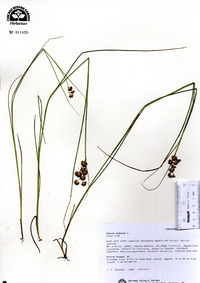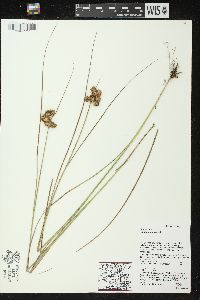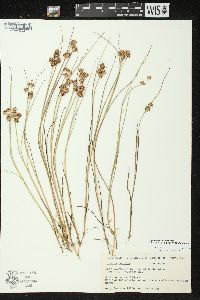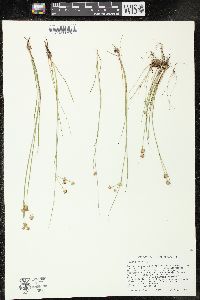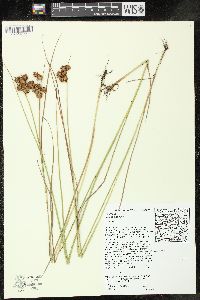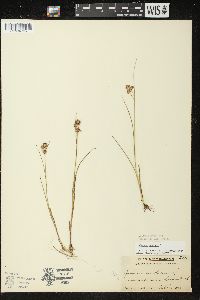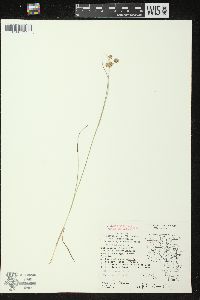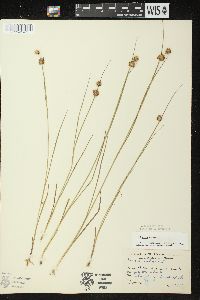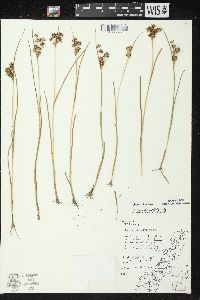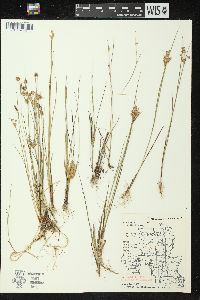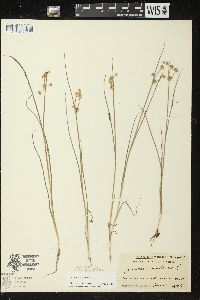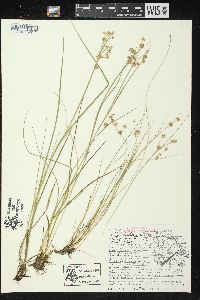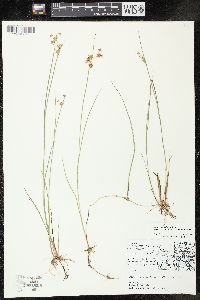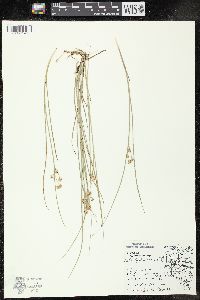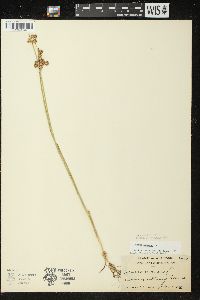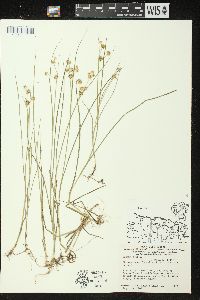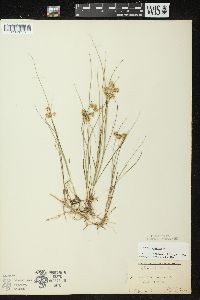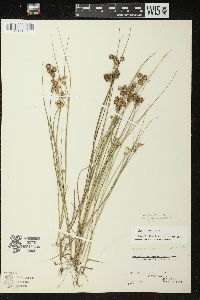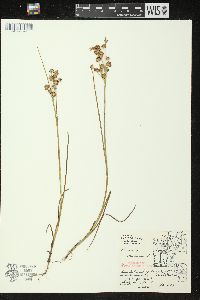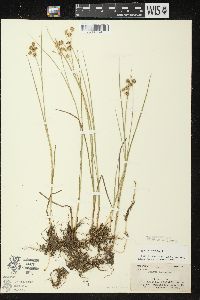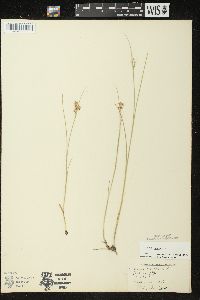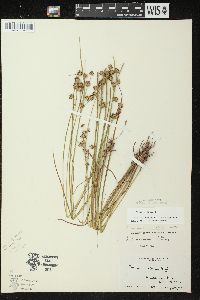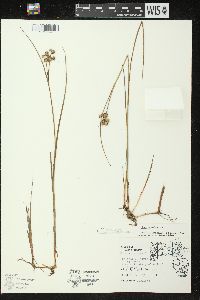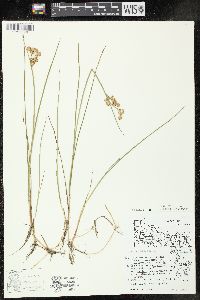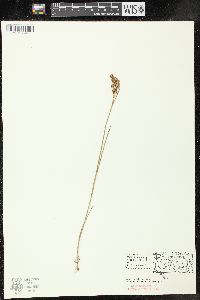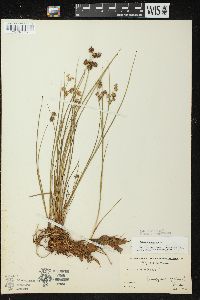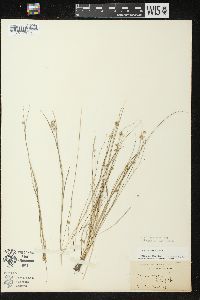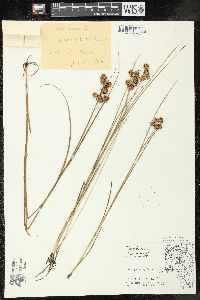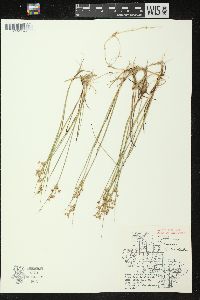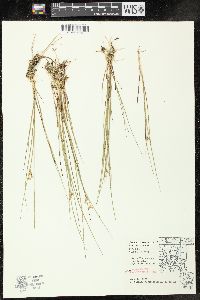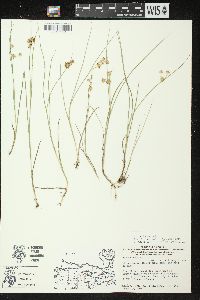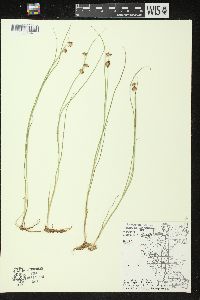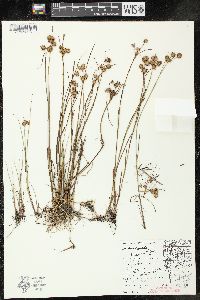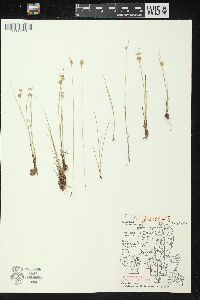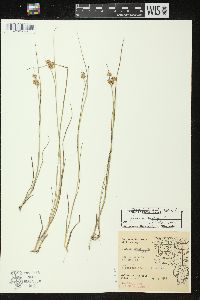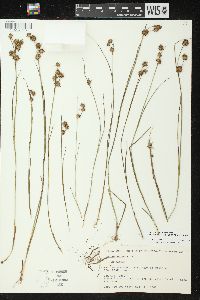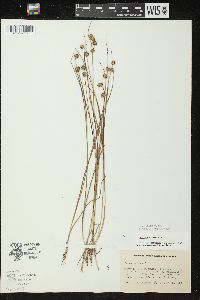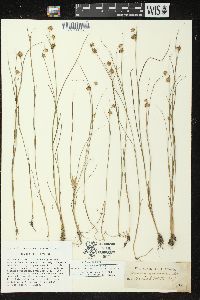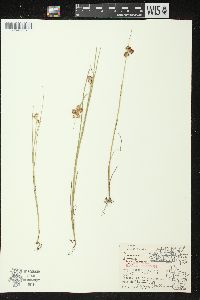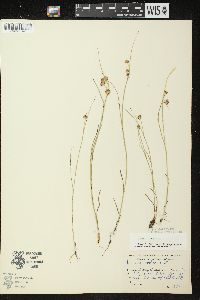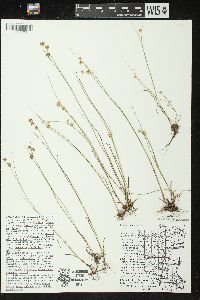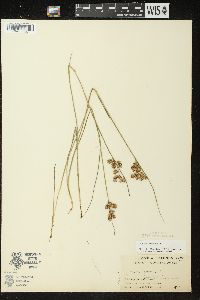Juncus nodosus
|
|
|
|
Family: Juncaceae
Knotted Rush
|
Herbs, perennial, rhizomatous, 0.4--5.5(--7) dm. Rhizomes with swollen nodes, 1 mm diam. Culms erect, terete, 1--3 mm diam., smooth. Cataphylls 0 or 1--2., pink to gray, apex acute. Leaves: basal 1, cauline 2--4, green to pink; auricles 0.5--1.7 mm, apex rounded, membranaceous to cartilaginous; blade terete, 6--30 cm x 0.5--1.5 mm. Inflorescences terminal racemes of 3--15 heads, 0.6--6 cm, branches ascending to erect; primary bract erect; heads 6--30-flowered, spheric, 6--10(--12) mm diam. Flowers: tepals green to light brown, lance-subulate, 2.4--4.1 mm, nearly equal, apex acuminate; stamens 3 or 6, anthers 1/2 to equal filament length. Capsules exserted, chestnut brown, 1-locular, lance-subulate, 3.2--5 mm, apex tapering, valves separating at dehiscence, fertile throughout or only proximal to middle. Seeds oblong, ellipsoid, or obovoid, 0.4--0.5 mm, not tailed. . 2n = 40. Fruiting early summer--fall. Sandy and muddy shores of lakes, streams, rivers, and estuaries (both freshwater and brackish), swamps, fens, salt marshes, and wet fields, often calcareous; 0--2200 m; Alta., B.C., Man., N.B., Nfld. and Labr., N.W.T., N.S., Ont., P.E.I., Que., Sask., Yukon; Alaska, Ariz., Calif., Colo., Conn., Del., Idaho, Ill., Ind., Iowa, Kans., Maine, Md., Mass., Mich., Minn., Mo., Mont., Nebr., Nev., N.H., N.J., N.Mex., N.Y., N.Dak., Ohio, Okla., Pa., R.I., S.Dak., Tex., Utah, Vt., Va., Wash., W.Va., Wis., Wyo.; Mexico (s to Puebla). The Texas populations and some of the northern Mexican populations consistantly have 3 stamens. These populations have been separated as Juncus nodosus var. meridionalis. Plants with 3 stamens are found elsewhere, however, and other significant characters do not appear to separate these populations.
Perennial grasslike forb 4 cm - 70 cm tall Leaves: one basal and two to four alternate on stem, green to pink, 6 - 30 cm long, 0.5 - 1.5 mm diameter, linear, grasslike, round in cross section, and with distinct crosswise partitions inside (septate). The leaves also have a membranous to firm (even almost boney), basal, 0.5 - 1.7 mm long, round-tipped, ear-like appendage (auricle) at the top of the leaf sheath. Inflorescence: a terminal, 0.6 - 6 cm long, compact, ascending or erect, very short-branched structure with branches ending in three to fifteen, spheric, 0.6 - 1.2 cm diameter flower clusters. Each flower cluster is a compact head of six to thirty, tiny, radially symmetric flowers. Stamens: usually six (rarely three), with anthers at least half the length of the filaments. Pistil: with one superior ovary, and three stigmas. Fruit: single-chambered, chestnut-brown, 3.2 - 5 mm tall (usually taller than tepals), three-angled, very narrowly lance-shaped capsules with slender-tapering, pointed tips. Stems: erect, smooth, round in cross section, 1 - 3 mm diameter, and arising from 1 mm diameter rhizomes with swollen nodes. Seeds: many, clear yellow-brown, 0.4 - 0.5 mm long, oblong to ellipsoid or inversely egg-shaped, with short-pointed or abruptly narrowed tips, but without distinct narrowed tails at the ends. Tepals: six in two whorls of three, green to light brown, all about equal length (2.4 - 4.1 mm), very narrowly lance-shaped with long-tapered pointed tips. Similar species: Juncus nodosus is very similar to and often confused with J. torreyi, but that species has the outer three tepals usually longer than the inner three tepals, the tepals have more rigid, awn-like tips, the leaf auricles at the top of the leaf sheaths are larger (1 - 4 mm long), the capsules are often about the same height as the tepals, and often the flower heads are converted to large vegetative bulblets that almost appear as insect galls. Any other similar species with six stamens and non-tailed seeds have fewer flowers per head and the heads consequently do not appear to be spheres. Since J. nodosus can have flowers with only three stamens, it can sometimes be confused with J. scirpoides, except that species differs by having shorter anthers (only about one-third as long as the filaments), and the auricles at the summit of the leaf sheaths are slightly longer (1 - 2 mm long). It may also be possible to confuse this species with J. brachycarpus, but the outer tepals are clearly longer than the inner three in that species. Finally, J. canadensis may superficially appear similar, but that species always has seeds with obvious tails at both ends and further, the seeds are covered with a whitish film. Flowering: June to October Habitat and ecology: Somewhat frequent in specific habitats with alkaline soils or substrates such as calcareous sandy or marly shores, calcareous springy areas, or even ditches. Occurence in the Chicago region: native Author: The Field Museum Stems slender, erect, 1.5-4 dm, arising singly from the nodes of slender rhizomes that are evidently tuberous-thickened at intervals; cauline lvs 2 or 3, the blades terete, septate, 0.5-2 dm נ0.7-1.5 mm, sheath-membrane yellowish, prolonged into membranous auricles 0.5-1 mm; heads mostly 2-10(-15) in a loose or congested, proliferating infl, globose, 5-25-fld, mostly 6-9 mm thick; fls eprophyllate; tep acuminate, but broader than in no. 30 [Juncus torreyi Coville], 2.5-3.5 mm, the pet about as long as the sep; stamens 6; fr slender, sharply triquetrous, 3.5-4.5 mm, equaling or commonly surpassing the tep, tapering into a slender, only tardily dehiscent stylar beak, unilocular, the placental partitions only slightly intruded; seeds apiculate, ca 0.5 mm; 2n=40. Bogs, marshes, and wet shores; Nf. to Mack. and B.C., s. to Va., Ind., Mo., Tex., and Calif. Gleason, Henry A. & Cronquist, Arthur J. 1991. Manual of vascular plants of northeastern United States and adjacent Canada. lxxv + 910 pp. ©The New York Botanical Garden. All rights reserved. Used by permission. From Flora of Indiana (1940) by Charles C. Deam Fairly common in the northern counties and known from a single locality in Wayne County. It is found in a variety of wet habitats: in marshes, bogs, and swales, occasionally in ditches and sloughs, but most commonly on low sandy or marly shores. No specimens were found to support Schneck's report from the Lower Wabash Valley. The relatively huge grotesque heads often produced by galls in many species of § Septati occur with greatest frequency in this species, although they are frequent too in J. torreyi, J. canadensis and J. acurninatus. …… Indiana Coefficient of Conservatism: C = 5 Wetland Indicator Status: OBL |

